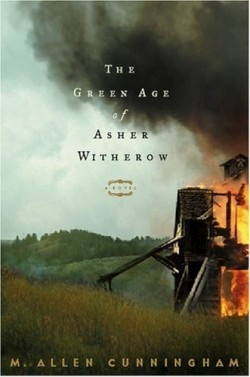
The Green Age of Asher Witherow
Asher’s name “sounds like the name of a dying thing,” declares his future love at their introduction. On the contrary, the title character of this novel is very much alive, though by story’s end he is intimately familiar with death. Asher’s green age (an allusion to the Dylan Thomas poem “The Force that Through the Green Fuse Drives the Flower”) spans the years from birth to thirteen, and, like the speaker the Thomas poem, he is never really green in anything but age. He speaks in full sentences at age one, begins work in a coalmine at seven, and reads Ovid and Emerson not long after.
Although growing up fast is the norm in Nortonville, California, Asher is more advanced than his playmates. Perhaps the same can be said of the author, who at twenty-six has produced a remarkable first novel, a feat reminiscent of William Styron’s Lie Down in Darkness, likewise published in the author’s twenty-sixth year. Not only are the stories of both novels carefully designed, but every sentence in each one is crafted with care.
Cunningham’s novel is narrated by an older Asher, trying to make sense of his youthful experiences, particularly his troublesome relationship with fire. Nortonville lies in the shadows of Mount Diablo and revolves around the coalmines, which might catch fire and wreak havoc at any moment. Asher is only too conscious of this reality, having watched his best friend burn to death in the belly of a mine on one of their boyhood adventures. Though he will accumulate more secrets, this one weighs on him the most. His burden is increased by his relationship with a teacher who recognizes Asher’s heightened sensitivity. “The world is fire,” he instructs the boy. “And we have the fire in us.”
Asher accepts this proclamation, already suspecting his alliance with the darker aspects of life: “Maybe I was built a little of blackness, a little of Nature’s bewitched side.” Although the older Asher may not completely understand the memories he relates, Cunningham’s control of the story is obvious. While the author directs his readers to more scholarly works for an accurate picture of 1860s and 1870s California life, his novel certainly offers a compelling look. Like the debut novel of Styron, now old enough to be Cunningham’s mentor, The Green Age should introduce this writer into the literary world even more concretely than his Pushcart Prize nominations for short fiction have already done.
Disclosure: This article is not an endorsement, but a review. The publisher of this book provided free copies of the book to have their book reviewed by a professional reviewer. No fee was paid by the publisher for this review. Foreword Reviews only recommends books that we love. Foreword Magazine, Inc. is disclosing this in accordance with the Federal Trade Commission’s 16 CFR, Part 255.
